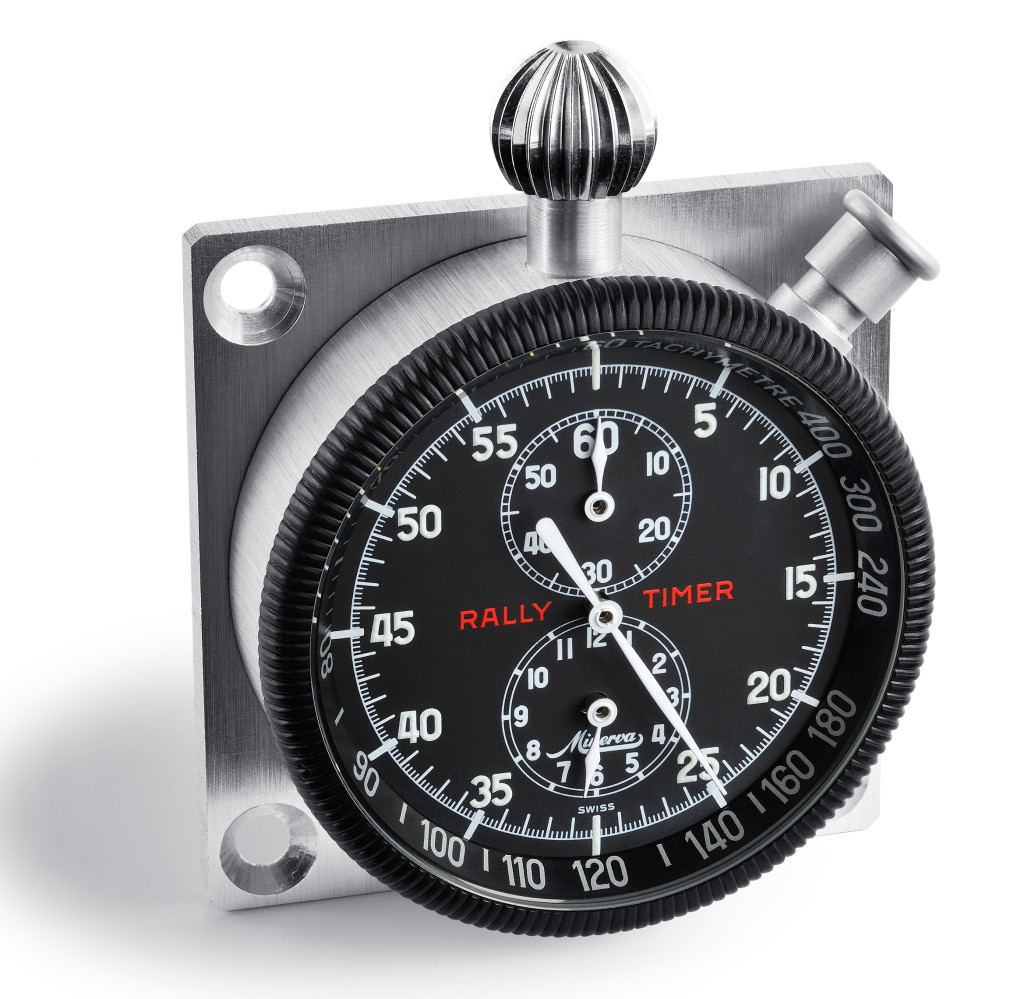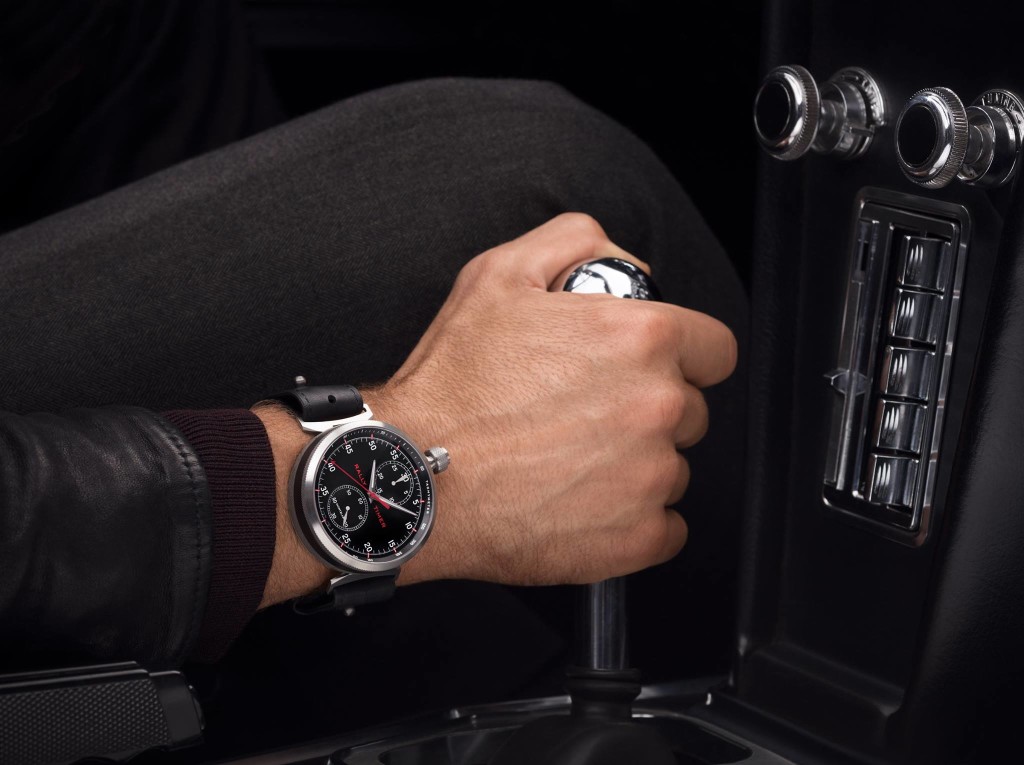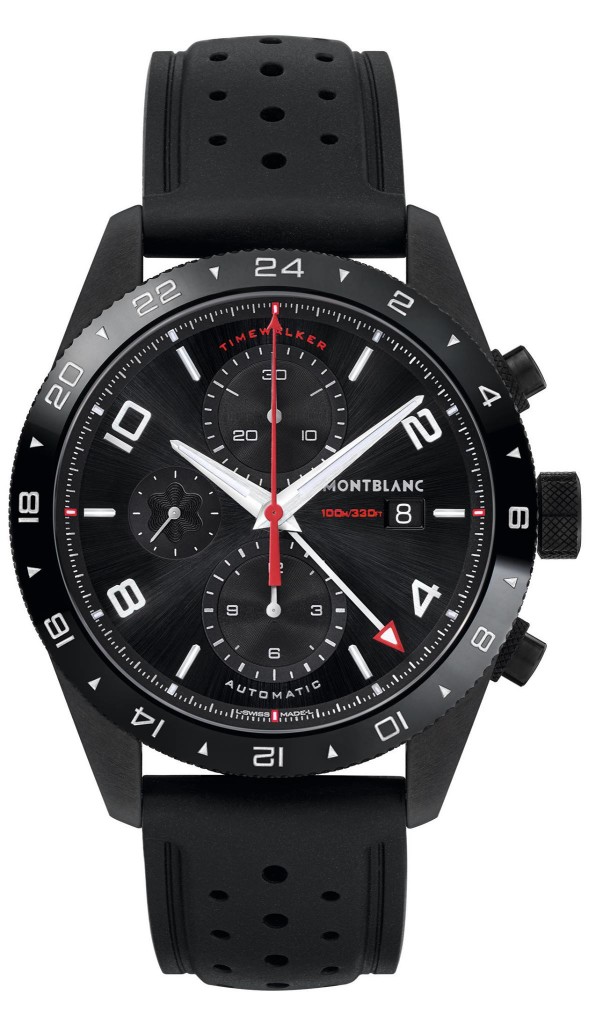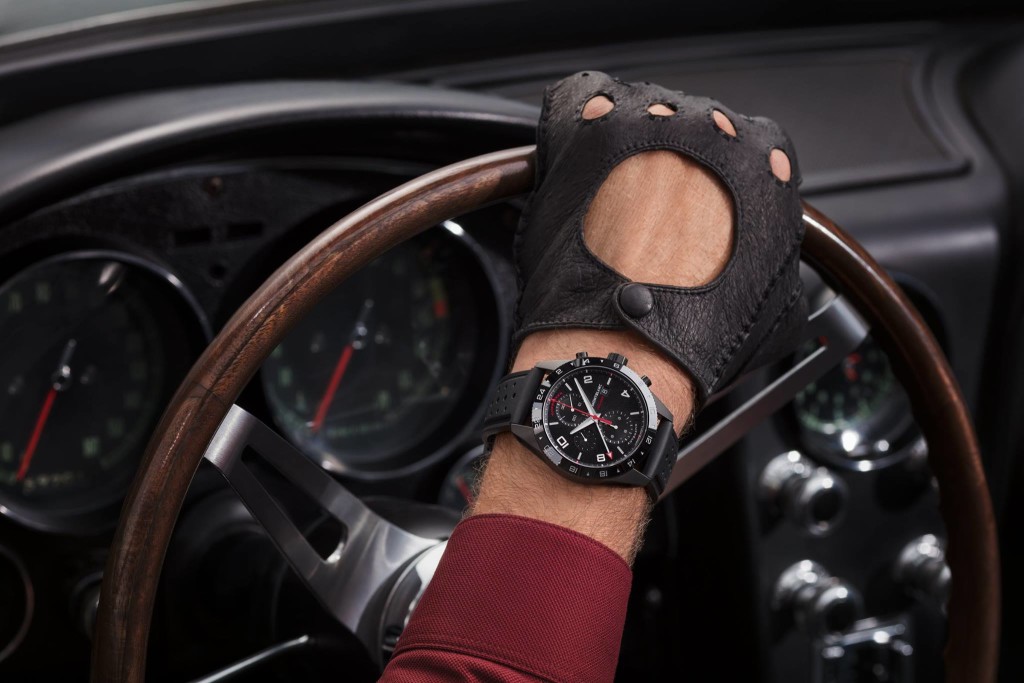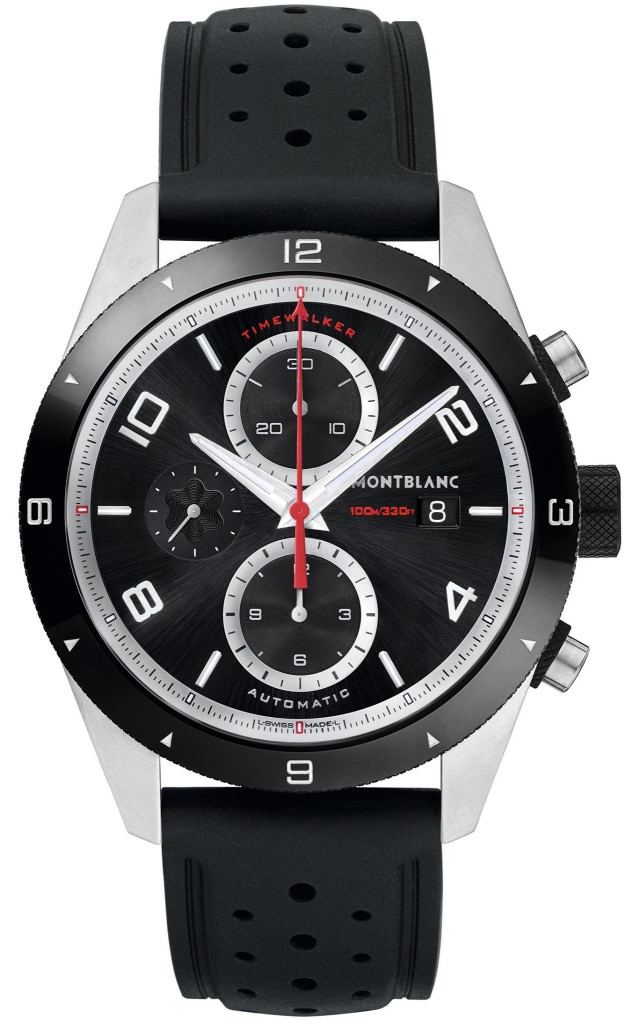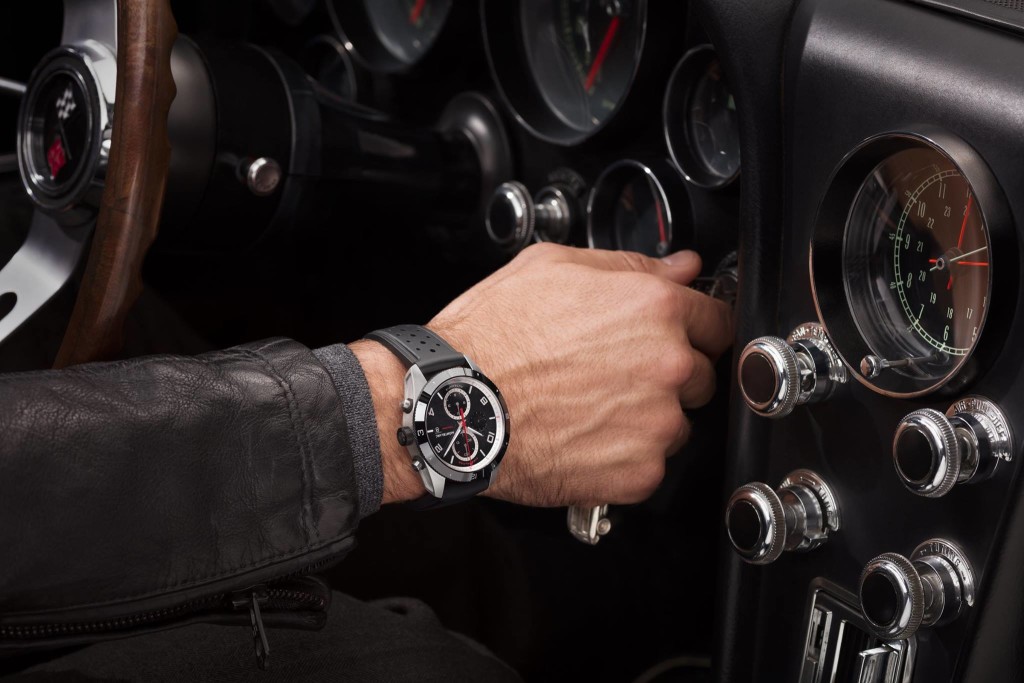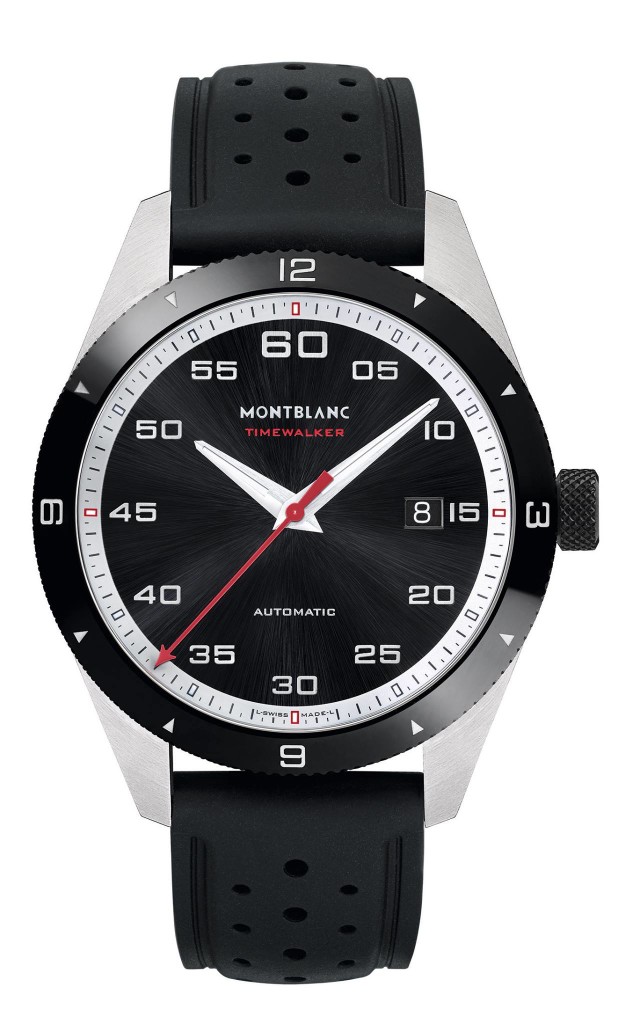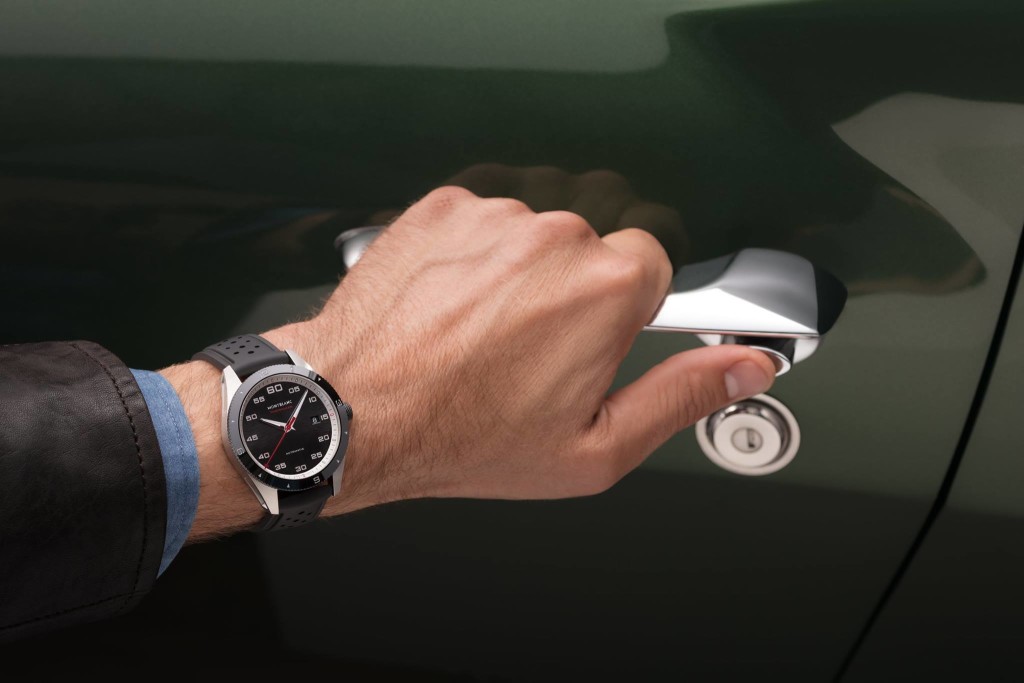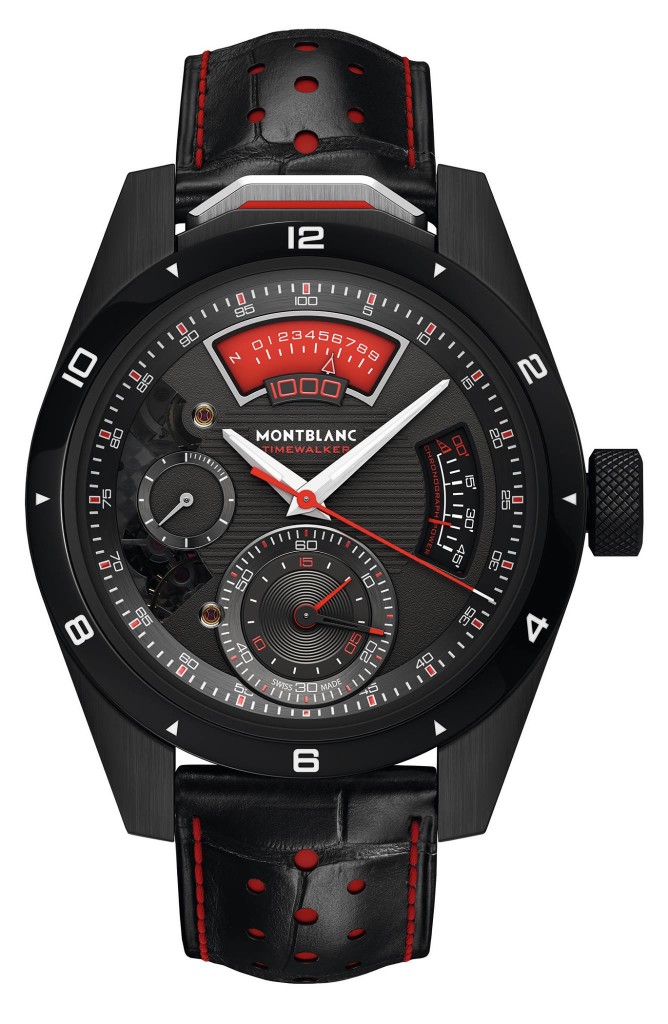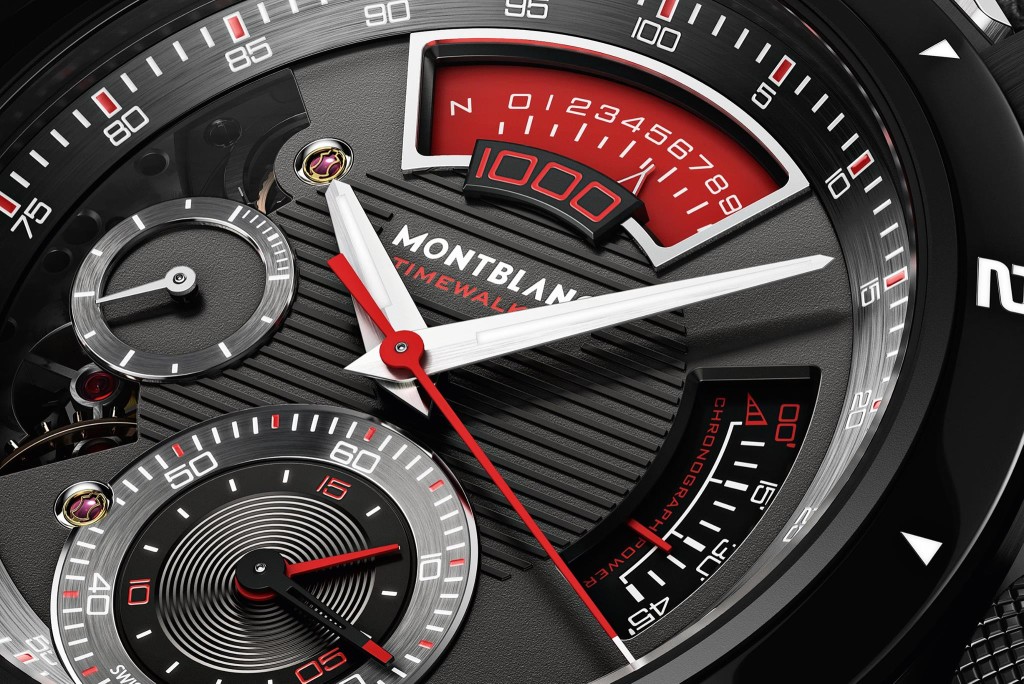Montblanc: TimeWalker Collection
30 January 2017Paying tribute to Minerva’s extraordinary heritage, Montblanc takes a journey back to the glory days of motor racing with five new TimeWalker timepieces that capture the beauty, spirit and values of motorsport history. The rebirth of these professional watches showcases the performance and innovation of the new Montblanc TimeWalker collection.
Montblanc TimeWalker Chronograph Rally Timer Counter
The famous Rally Timer stopwatch produced by Minerva for recording road racing is the inspiration behind this new Montblanc TimeWalker Chronograph Rally Timer Counter Limited Edition 100. This innovative timepiece offers different ways to appreciate the time, with the possibility of transforming the wristwatch into a pocket watch or a dashboard clock. The wristwatch, with its black leather calf strap, can be easily converted into a pocket watch by simply folding the strap attachments under the case and turning the case from 0 to 180 degrees. The pocket watch can then be either placed on a table thanks to two arms below the case, used as a stopwatch with the strap as a handle for utmost security, or clipped into a metal plate covered with leather that attaches to a car’s dashboard, offering an extremely legible timepiece when behind the wheel.
The 50 mm case is crafted out of grade-two titanium and has been satinated in order to enhance the structure of the metal. The middle section of the case has also been knurled and coated with black DLC. Satin-finished titanium is also the material of choice for the vintage-inspired knurled monopusher, crown and the versatile strap attachments. Turn the timepiece over, and the details continue with an opened caseback in the shape of a car grill that reveals the beauty of the Manufacture manually-wound monopusher chronograph calibre MB M16.29. The chronograph’s 30-minute counter at 12 o’clock is vertically aligned with the small seconds subdial at 6 o’clock, reminiscent of the original Minerva Rally Timer. In the centre, the red chronograph second hand runs along a tachymeter scale, which can be used to calculate speeds over fixed distances.
The timepiece is powered by the Manufacture manually wound monopusher chronograph calibre MB M16.29 that features a column wheel, horizontal coupling and a power reserve of 50 hours. The calibre takes its inspiration from the original Minerva calibre 17.29 developed in the 1930s, used for both pocket watches and wristwatches. This modern-day version is recognisable thanks to its beautiful hand-crafted finishings—Côtes de Genève stripes, inner angles, circular graining and bevelling—as well as its fine details such as the iconic Minerva arrow, a chronograph bridge shaped in the form of a “V”, and a large screwed balance that has a traditional frequency of 18,000 semi-oscillations per hour.
For utmost reliability and performance, the timepiece is water-resistant to 30 metres and has been rigorously tested by the Montblanc Laboratory Test 500, simulating intense real-life wear for over 500 hours.
Montblanc TimeWalker Chronograph UTC
The Montblanc TimeWalker Chronograph UTC combines design with practical functionality thanks to its chronograph and dual time complications.
The timepiece owes its contemporary looks to its bold black case with semi- skeletonized horns and mix of high-tech materials, such as black DLC, high-tech black ceramic and black rubber. The black DLC case comes in a 43 mm size with the addition of the emblematic unidirectional rotating black bezel made of shiny ceramic for utmost robustness and durability, which is knurled on the flank for a better grip and includes a silvery-white engraved 24-hour scale for greater legibility. The black DLC crown and pushers have also been finished with a knurled decoration that takes its inspiration from the design of the petrol caps popular in classic racing cars. The black dial features strong colour contrasts with silver and red elements and three-dimensional counters that resemble car dashboards from the past. The chronograph seconds are indicated via the red central hand with the tip shaped in the form of the Minerva arrow, while the chronograph hours are displayed in a subdial at 6 o’clock, and the 30-minute chronograph counter is positioned at 12 o’clock.
The Montblanc TimeWalker Chronograph UTC is equipped with the calibre MB.25.03 that shows the time in three different time zones. Local time is indicated with the rhodium-plated hands, and the home time can be read via a dark central hand enhanced with a red arrow and SuperLuminova at its tip. The readings are accompanied by a 24-hour scale on the bezel. The local time is set via the crown, allowing a quick and simple adjustment of the time in hourly increments without affecting the functioning of the minutes. The date is synchronised with the local time. A third time zone can be easily indicated at any time by turning the unidirectional rotating bezel to the new time zone—the location of the 24-hour hand being the point of reference.
The Montblanc TimeWalker Chronograph UTC comes with a choice of a perforated leather strap or a perforated rubber strap with a black lining that shows through the holes. For. All strap options are equipped with a new triple folding clasp .
Each Montblanc TimeWalker Chronograph UTC is water-resistant to 100 metres and has been rigorously tested by the Montblanc Laboratory Test 500, simulating real-life wear for over 500 hours.
Montblanc TimeWalker Chronograph Automatic
Continuing the motor racing theme, the new Montblanc TimeWalker Chronograph Automatic is rooted in the world of racing with details that recall the golden years of motoring with a chronograph function that is legible and stylish for today’s gentlemen drivers. The vintage car codes are visible throughout the watch, starting with the 43 mm stainless steel case. The Montblanc TimeWalker Chronograph Automatic features the unidirectional rotating black bezel knurled on the flank and made of shiny high-tech black ceramic for utmost robustness and durability. Ceramic has impressive properties such as a high-resistance to scratches, non-oxidization, a unique shiny surface, and a defence against all common chemical agents. The bezel can be used as a second time zone indicator. The horns have been semi-skeletonized like the air inlets of a car’s body, and the black DLC crown and chronograph pushers have been knurled like vintage petrol caps for better gripping. Completing the motor racing design, the case back has been fitted with a smoked glass opening, reminiscent of the glass windows that cover powerful V12 engines, and the straps include perforation holes, much like the leather driving gloves.
The black dial features strong colour contrasts with silvery-white and red elements, as well as three-dimensional counters that bring back memories of vintage dashboards. Distinctive design codes include a red chronograph seconds hand in the centre, which has a tip sculpted in the form of the Minerva arrow; chronograph hours which are displayed in a subdial at 6 o’clock, and a 30-minute chronograph counter positioned at 12 o’clock.
All the readings are highly legible thanks to black rhodium-plated dauphine hands injected with SuperLuminova, and a precise silvery-white minute track that has also be enhanced with both SuperLuminova and red markers for the 15-minute marks, providing excellent visibility both in the day and at night.
The Montblanc TimeWalker Chronograph Automatic is powered by the calibre MB 25.07 and comes with a choice of three different strap options: perforated leather, perforated rubber, and a new performance metal bracelet with three links.
All strap and bracelet options are equipped with a new triple folding clasp that was developed specially for the Montblanc TimeWalker Collection to offer a safe grip, flexibility and maximum comfort.
To reach high reliability and performance, each Montblanc TimeWalker Chronograph Automatic is water-resistant to 100 metres and has been rigorously tested by the Montblanc Laboratory Test 500, simulating real-life wear for over 500 hours.
Montblanc TimeWalker Automatic Date
The Montblanc TimeWalker Automatic Date is proposed with a 41 mm stainless steel case combined with an unidirectional rotating black bezel made of shiny high-tech black ceramic that allows the user to track a second time zone if desired.
Powered by the automatic calibre MB 24.17, the indications include the hours, minutes and seconds in the centre and a date in an aperture at 3 o’clock. The readings are all highly legible thanks to large Arabic numerals, a precise silvery-white minute track, and red markers. The seconds hand has also been highlighted with the tip of the Minerva arrow a nod to the rich horological heritage of the TimeWalker collection. The dial with its scale from 5 to 60 is clearly reminiscent of the Minerva stopwatch dials from the beginning of the 20th century.
The design codes from the racing world can be found in the semi-skeletonized horns that are reminiscent of the air intakes on a car’s bonnet, the knurled finishing on the black DLC crown which has been inspired by the petrol tank cap on vintage racing cars, and the black perforated straps (either in leather or rubber) that look like the driving gloves that racing drivers wore in the past. There is also the choice of an elegant and new performance metal bracelet with three links. All straps come with satinated stainless steel pin buckles.
To reach maximum reliability and performance, each Montblanc TimeWalker Automatic Date is water-resistant to 100 metres and has been rigorously tested by the Montblanc Laboratory Test 500, simulating real-life wear for over 500 hours.
Montblanc TimeWalker Chronograph 1000 Limited E. 18
Montblanc continues to innovate with the Montblanc TimeWalker Chronograph 1000 Limited Edition 18, a mechanical chronograph that measures elapsed time to the 1/1000th of a second. In the spirit of motor racing, this limited edition embraces the world of motorsports through and through.
The chronograph power reserve indicator is inspired by old fuel gauges, while the black and red details and the 1/1000th of a second indication are reminiscent of early dashboards. Knurled crowns and bezels evoke vintage petrol tank caps, and red holes in the black alligator strap are typical of the driving gloves. The timepieces feature a high-frequency balance wheel that has also been inspired by the performance of racing cars, and a monopusher chronograph at 12 o’clock, which mirrors the Minerva stopwatches that were used for timing car races.
A sophisticated combination of high-tech materials has been chosen for the Montblanc TimeWalker Chronograph 1000 Limited Edition 18, starting with the 46.4 mm titanium case and semi-skeletonized horns that have all been satinated and treated with a black DLC coating for ultimate scratch-resistance, robustness and lightness. The case is complemented by a titanium monopusher at 12 o’clock and a fixed black ceramic bezel that has been engraved with white Arabic numerals
The dial is a multi-layer construction with black horizontal stripes, red indications and a red gasket, which is framed by a smoked sapphire crystal, enhancing the sporty and racing aesthetic.
The Montblanc TimeWalker Chronograph 1000 Limited Edition 18 works thanks to one movement with two hearts: the first heart indicates the time functions, and the second one is in charge of the chronograph indications. The hours and minutes are at the centre of the dial with the addition of a small second counter with a rhodium-plated hand at 9 o’clock. The hour, minute and second displays keep time thanks to a large balance with 18 screws, which beats at 18,000 semi-oscillations per hour. This balance wheel is partially visible through the skeletonized dial at 7 o’clock. All other indicators serve the chronograph function. The chronograph’s small balance can be seen at 10 o’clock showing oscillations at a rate of 360,000 semi-oscillations per hour (50 Hz). In order to allow a finer adjustment and then further improve its precision, the chronograph’s small balance wheel has been equipped with two hairsprings, which are fixed on top of each other.
When an elapsed interval is being measured, the chronograph’s elapsed 100th of a second hand orbits the entire dial once per second. But rather than occurring as a smooth progression, this circular motion is sub-dived into 100 individual steps which the naked eye cannot distinguish from one another. The chronograph’s centre-wheel, to which the central chronograph hand is affixed, likewise jumps from one tiny step to the next in a hundredth of a second increments. However, the thousandths of a second are measured in an entirely different way.
In order to go further and measure a thousandth of a second, the Montblanc engineers had developed a movement with a balance beating with a frequency of 360,000 semi-oscillations per hour. This rapid oscillator completes 100 to-and-from motions per second, i.e. 50 times in one direction and 50 times in the other. This tempo not only guides the motion of the 1/100th dedicated mechanism, but it also sets the pace for delivering an impulse of energy that sets into rotation an innovative wheel in the gear train, the so-called “thousandth wheel”. Powered in this fashion, it rotates around its own axis at a uniform speed of ten rotations per second and thus provides the resolution with which hundredths of a second can be further divided into sets of ten increments. The chronograph is controlled by a two-level column-wheel: one level controls the whip to start, stop and reset the seconds, minutes and the thousandths of a second, and the other level guides the hammers to reset the seconds and the minutes. The reset of the 100th-of-a-second hand is accomplished in a particular way thanks to a disc with a catch at the centre of the movement. This catch, made of an alloy of copper, improves the reliability of the mechanism.
Rather than remaining continually in motion, the separate balance for the chronograph begins to vibrate only when the start function is activated by a flexible steel lamella or whip mounted behind the arrowhead of the chronograph rocker. When the stop function is triggered, this slender steel plate stops the small 50-Hertz balance and holds it motionlessly in place until it is needed again.
The chronograph function is powered by its own barrel, which stores enough energy to measure intervals of up to 45 minutes in duration. An elapsed-time measurement can be indefinitely extended by turning the crown anti-clockwise while the chronograph is running, thus adding fresh energy to the chronograph’s barrel. The going train for the ordinary time display draws its energy from a second barrel that guarantees a 100-hours of power reserve.
This long-lasting power reserve also contributes to the regularity of the amplitude of the balance beating at 360’000 oscillations per hour which, in turn, enhances the precision of the time measuring—a decisive advantage for accurately measuring intervals to the nearest thousandth of a second.
The Montblanc TimeWalker Chronograph 1000 Limited Edition 18 is surprisingly easy to read as it follows a familiar pattern that is found on the vast majority of chronographs. A double counter at 6 o’clock has a longer, red-tipped hand to tally elapsed seconds from 1 to 60, as well as a shorter, all-red hand to count a maximum of 15-elapsed minutes. The chronograph’s indicators begin with a red, centrally axial, elapsed 100th of a second hand that completes one full 360° rotation every second so that its tip sprints along the hundredths-of-a-second scale on the dial’s periphery. The thousandths of a second is displayed at 12 o’clock on a cartouche inspired by the speedometer of vintage car dashboards, where a triangular red pointer progresses along a scale calibrated from 0 to 9. The resting position is indicated by the letter “N” (for neutral), leaving the 0 to clearly indicate the thousandths, i.e. one full 100th of a second.
A slightly inset display at 3 o’clock indicates the remaining reserve of power for the chronograph’s movement which, when fully wound, will operate for more than 45 minutes. The power-reserve display also serves as a helpful indicator for the chronograph because it shows how much longer the chronograph will continue to run beyond the 15-elapsed minutes it can tally.
The mainspring for the ordinary timekeeping movement is wound by turning the crown clockwise (the power reserve is about 100 hours). Turning the crown counter-clockwise winds the separate mainspring for the chronograph’s movement, which delivers optimal measuring results for more than forty-five consecutive minutes. To tally lengthier intervals, power can be conveyed to the chronograph’s barrel by turning the crown while the chronograph is running. Pressing the button between the horns at 12 o’clock starts the chronograph and sets the long red chronograph second hand in motion as it races around the main dial once per second. Double counters at 6 o’clock tally its rotations. The small red hand on the chronograph’s power-reserve display gradually progresses upwards, and the 1,000th-of-a-second arrowhead at 12 o’clock points motionlessly toward the “N”. When the chronograph button is pressed again, the entire system instantly halts and the duration of the elapsed interval can be read: beginning with the number of elapsed minutes on the inner scale on the double counter at 6 o’clock, followed by the elapsed seconds on the outer scale of the same subdial, continuing with the hundredths of a second on the peripheral scale surrounding the main dial, and culminating with the thousandths of a second in the display at 12 o’clock. The entire process is simple, clear, quick and requires no additional calculations.
Equipped with Montblanc’s Manufacture Calibre MB M66.26, this manually wound monopusher chronograph is decorated to the finest standards of Swiss watchmaking with decorations and finishings that include Côtes de Genève, circular graining, hand chamfering and burnishing.

